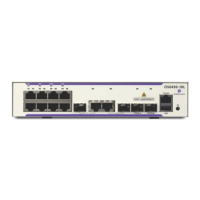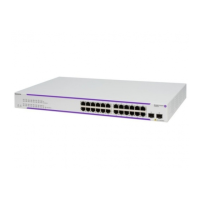OmniSwitch OS6860/OS6900/OS10K Troubleshooting Guide Part No.032996-00 Rev.A
AOS Release 7.X and 8.X January 2015
Alcatel-Lucent Page 87 of 148
The OSPF Hello timer and Dead interval timer plays a key role in achieving sub-second convergence
using graceful restart.
These timers should be based around the time taken between the last Hello packet sent by the
deceased Master chassis and the first Hello packet sent by the Slave chassis post takeover.
This directly depends on the time taken by the Slave chassis to detect the Master chassis failure and
time taken for the IP interfaces to come UP on the Slave chassis.
Considering this dependency, the OSPF Hello timer and Dead interval timer MUST be non-
aggressive.
Having aggressive value for these timers can result in adjacency break down between the restarting
router and neighboring routers before the Graceful LSA Update message was sent.
This results in failure to achieve sub-second convergence during VC takeover.
Default timer values for Hello timer (10 seconds) and Dead Interval timer (40 seconds) are
recommended for OSPF Graceful Restart Support.
Significance of BFD during Virtual Chassis Takeover
The BFD feature helps OSPF for sub-second convergence when there is a fault in the bidirectional path
between the adjacent routers. This is achieved by establishing BFD sessions (simple Hello mechanism with
short intervals) between neighboring routers. The BFD session runs in the NI. When the NI application detects
a failure in the BFD session, it gets communicated to the CMM application which in turn informs the
registered protocol application to take necessary action.
In the case of a Virtual Chassis setup, the NI application in the Slave chassis will be UP and maintain the BFD
session between the neighboring routers. This way the BFD sessions are not broken and there will not be any
system/link failure reported to OSPF protocol application. Due to this, there is no significance for BFD
configuration in OSPF takeover process.
12.3. Minimum working configuration
-> show configuration snapshot ospf ip
! IP:
ip interface "vlan1" address 192.168.1.1 mask 255.255.255.0 vlan 1
! OSPF:
ip load ospf
ip ospf area 0.0.0.0
ip ospf interface "vlan1"
ip ospf interface "vlan1" area 0.0.0.0
ip ospf interface "vlan1" admin-state enable
ip ospf admin-state enable
12.4. Basic troubleshooting
Displays the OSPF status and general configuration parameters:
-> show ip ospf
Router Id = 192.168.1.1,
OSPF Version Number = 2,
Admin Status = Enabled,
Area Border Router ? = No,
AS Border Router Status = Disabled,
Route Tag = 0,
SPF Hold Time (in seconds) = 10,
SPF Delay Time (in seconds) = 5,
MTU Checking = Disabled,
# of Routes = 1,
# of AS-External LSAs = 0,
# of self-originated LSAs = 1,
# of LSAs received = 2,
External LSDB Limit = -1,

